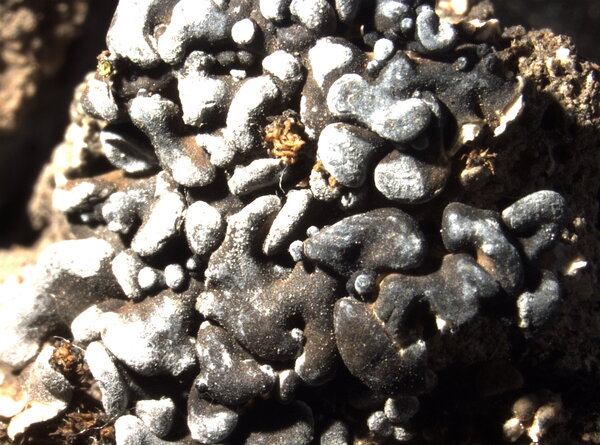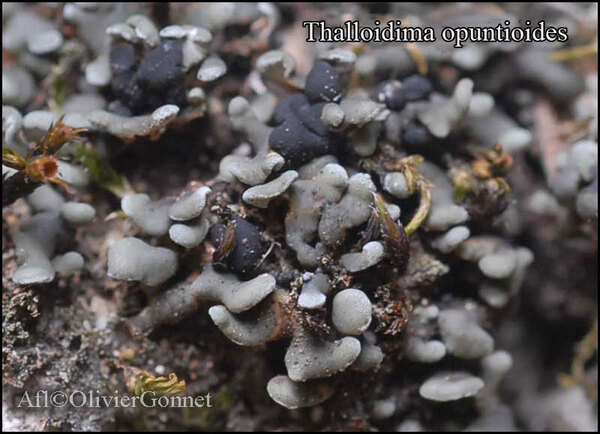Thalloidima opuntioides (Vill.) Kistenich, Timdal, Bendiksby & S.Ekman
Taxon, 67: 897, 2018.. Basionym: Lichen opuntioides Vill. - Hist. Pl. Dauphiné, 3: 967, tab. 55, 1789.
Synonyms: Toninia bornmuelleri (J. Steiner) Zahlbr.?; Toninia opuntioides (Vill.) Timdal
Distribution: N - VG (TSB 1419), Frl, Ven (Nascimbene & Marini 2007), TAA, Piem (Giordani & al. 2014), Lomb, VA (Piervittori & Isocrono 1999), Lig (Giordani & al. 2025). C - Tosc (Benesperi 2006, 2007b), Marc (Nimis & Tretiach 1999), Umb (Genovesi & al. 2001, Ravera & al. 2006, Panfili 2007, Brackel 2015), Laz (Nimis & Tretiach 2004), Abr (Nimis & Tretiach 1999), Mol (Nimis & Tretiach, 1999, 2004, Caporale & al. 2008, Genovesi & Ravera 2014). S - Camp (Aprile & al. 2003b, Nimis & Tretiach 2004, Garofalo & al. 2010), Pugl (Brackel 2011), Bas (Brackel 2011), Cal (Puntillo 1996).
Description: Thallus squamulose to subfruticose, olivaceous grey to reddish brown, whitish pruinose at the margin especially near the tips of squamules, usually with shallow cracks in the cortex. Squamules (2-)3-6 mm broad, ascending to erect, convex to bullate when young, later vertically flattened and irregularly imbricate, often with swollen ends; lower surface pale brown to white. Upper cortex 30-90 μm thick including an up to 50 μm thick epinecral layer, sometimes with crystals of calcium oxalates; medulla white, with crystals soluble in acetone, but insoluble in K and N; lower cortex thinner than upper cortex. Apothecia frequent, lecideine, sessile, strongly constricted at base, up to 4 mm across, with a black, sometimes weakly pruinose, more or less flat, smooth disc, and a distinct, smooth, concolorous margin. Proper exciple brownish to dark reddish brown, sometimes with a dark grey rim reacting K+ and N+ violet; epithecium grey, K+ and N+ violet; hymenium colourless, 60-70 μm high; paraphyses coherent, simple or sparingly branched and anastomosing in upper part, thin-walled, the apical cell distinctly swollen and covered by a gelatinous pigment cap; hypothecium medium brown to dark reddish brown in upper part, pale brown to colourless in lower part. Asci 8-spored, clavate, surrounded by a gelatinous I+ blue coat, with a well-developed I+ blue tholus, an I+ darker blue tube and a well-developed ocular chamber, Bacidia-type. Ascospores 1-septate, hyaline, fusiform, 16-25 x 3-5 μm. Photobiont chlorococcoid. Spot tests: thallus K-, C-, KC-, P-, UV-. Chemistry: thallus with an unidentified terpenoid, in t.l.c. turning bright yellow on charring; Sedifolia-grey pigment in apothecia.Note: a widespread, arctic to temperate, circumpolar lichen found often amongst bryophytes, always associated to cyanobacterial colonies or cyanobacterial lichens when young.
Growth form: Squamulose
Substrata: rocks, soil, terricolous mosses, and plant debris
Photobiont: green algae other than Trentepohlia
Reproductive strategy: mainly sexual
Commonnes-rarity: (info)
Alpine belt: very rare
Subalpine belt: rare
Oromediterranean belt: rare
Montane belt: rather rare
Submediterranean belt: very rare
Padanian area: absent
Humid submediterranean belt: very rare
Humid mediterranean belt: absent
Dry mediterranean belt: absent
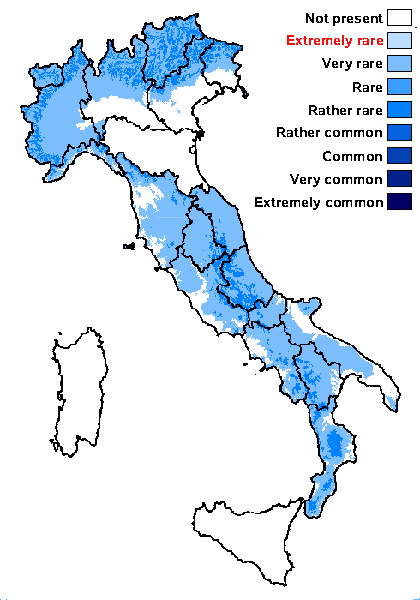
Predictive model
Herbarium samples
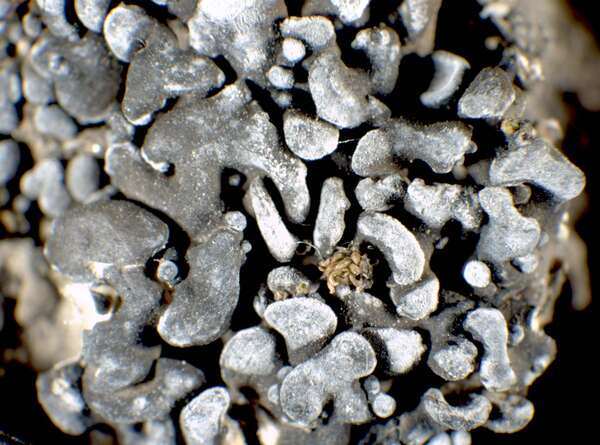

P.L. Nimis; Owner: Department of Life Sciences, University of Trieste
Herbarium: TSB (1419)
2001/12/01
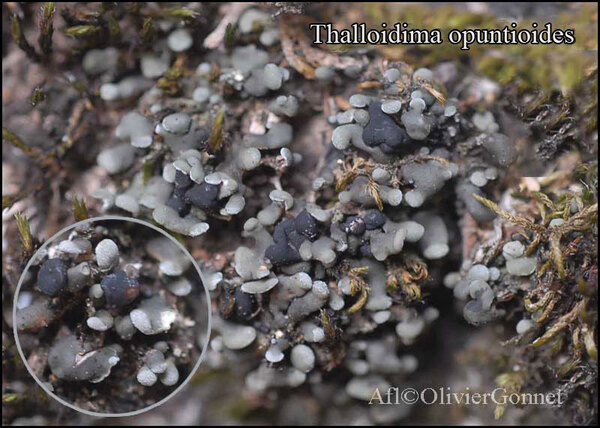
Courtesy Danièle et Olivier Gonnet - Source: hhttps://www.afl-lichenologie.fr/Photos_AFL/Photos_AFL_T/Textes_T2/Thalloidima_opuntioides.htm
France, rocher calcaire fissuré - session AFL 2005 - Lozère
Growth form: Squamulose
Substrata: rocks, soil, terricolous mosses, and plant debris
Photobiont: green algae other than Trentepohlia
Reproductive strategy: mainly sexual
Commonnes-rarity: (info)
Alpine belt: very rare
Subalpine belt: rare
Oromediterranean belt: rare
Montane belt: rather rare
Submediterranean belt: very rare
Padanian area: absent
Humid submediterranean belt: very rare
Humid mediterranean belt: absent
Dry mediterranean belt: absent

Predictive model
| Herbarium samples |


P.L. Nimis; Owner: Department of Life Sciences, University of Trieste
Herbarium: TSB (1419)
2001/12/01

 INDEX FUNGORUM
INDEX FUNGORUM
 GBIF
GBIF
 DOLICHENS
DOLICHENS
